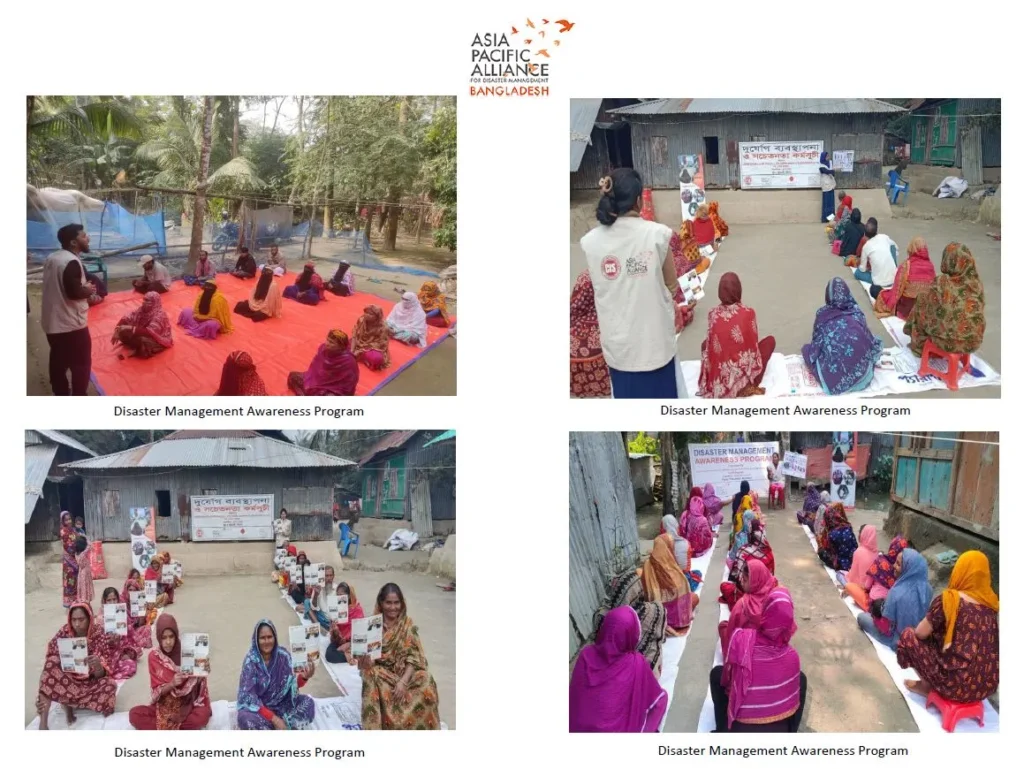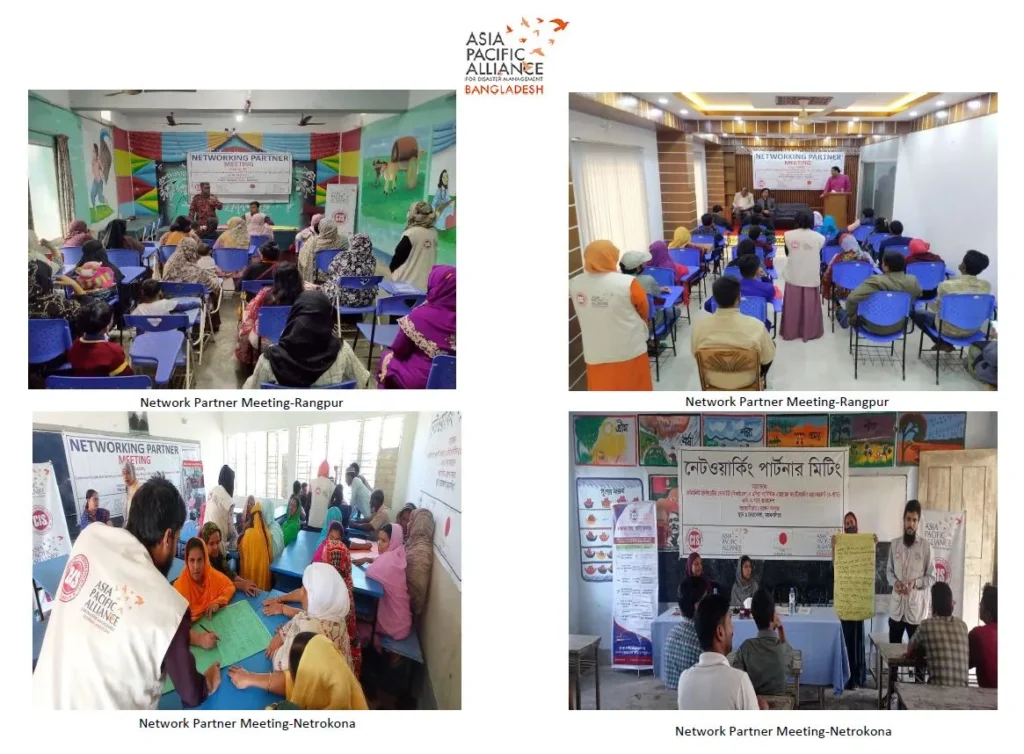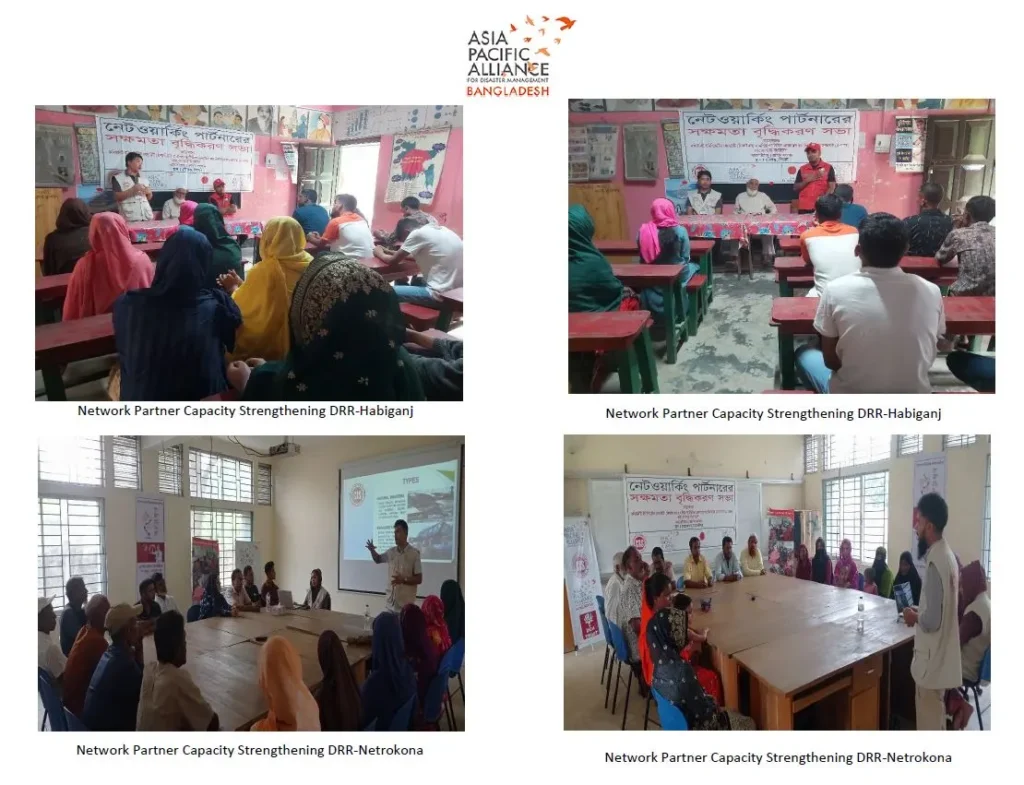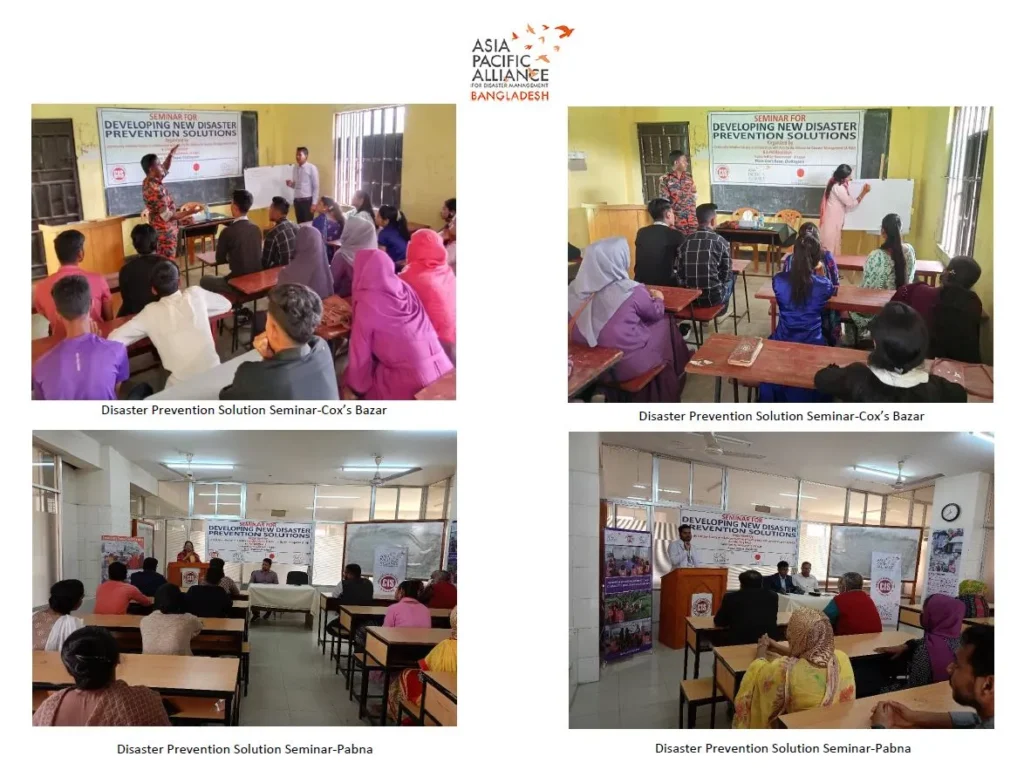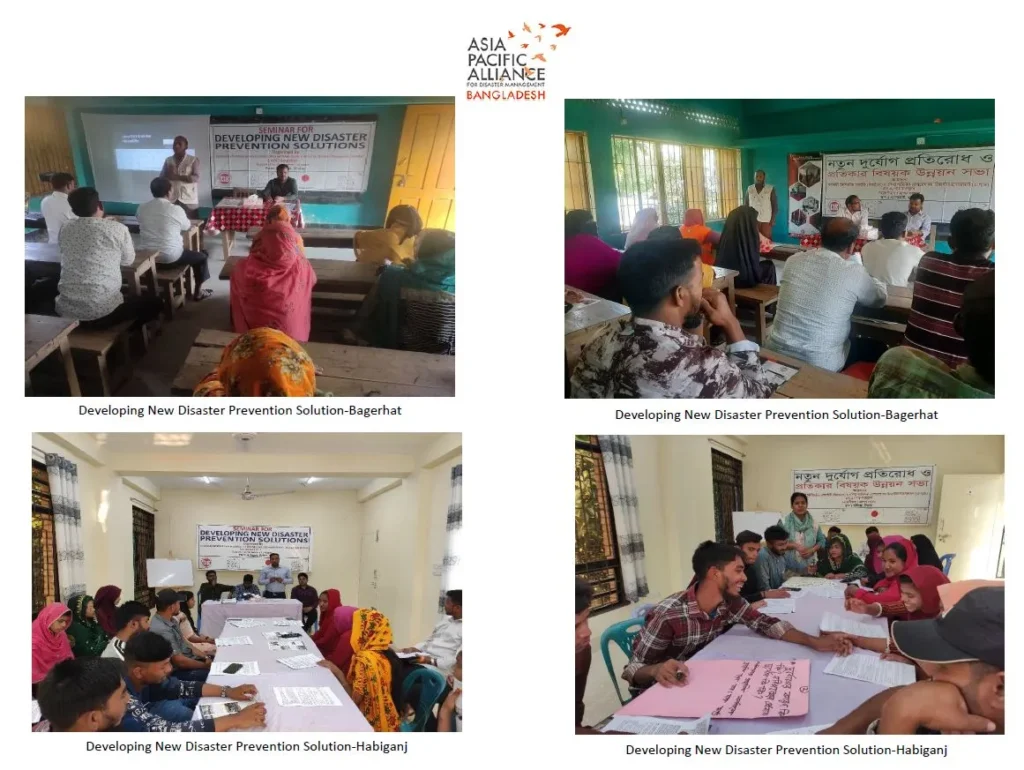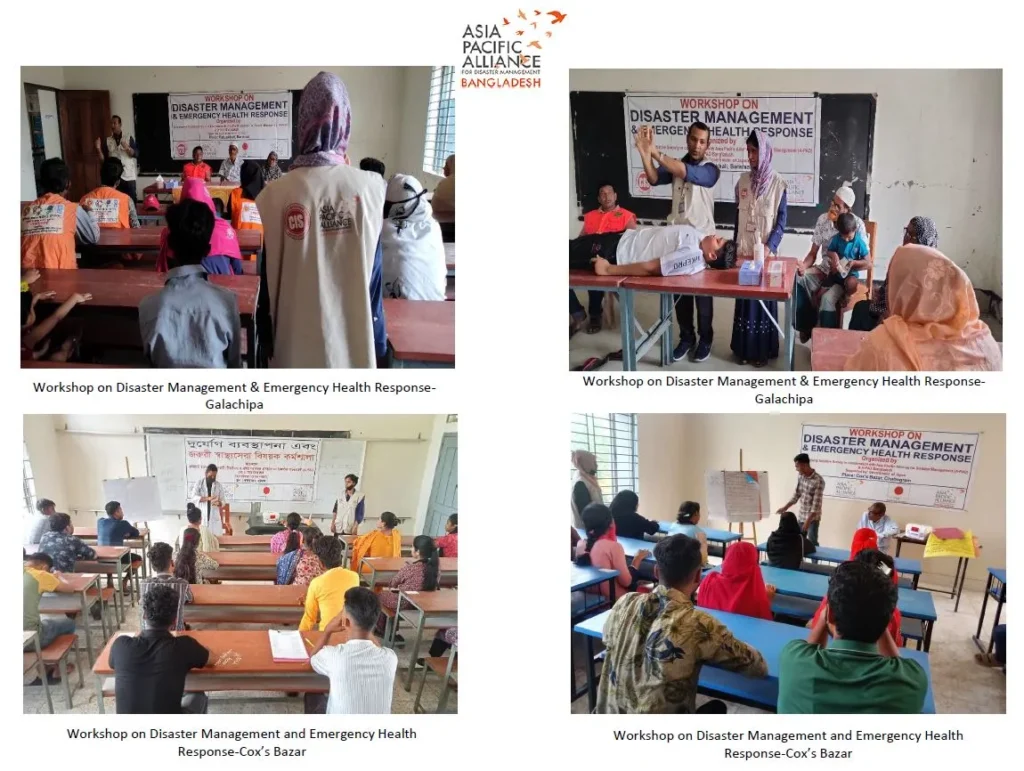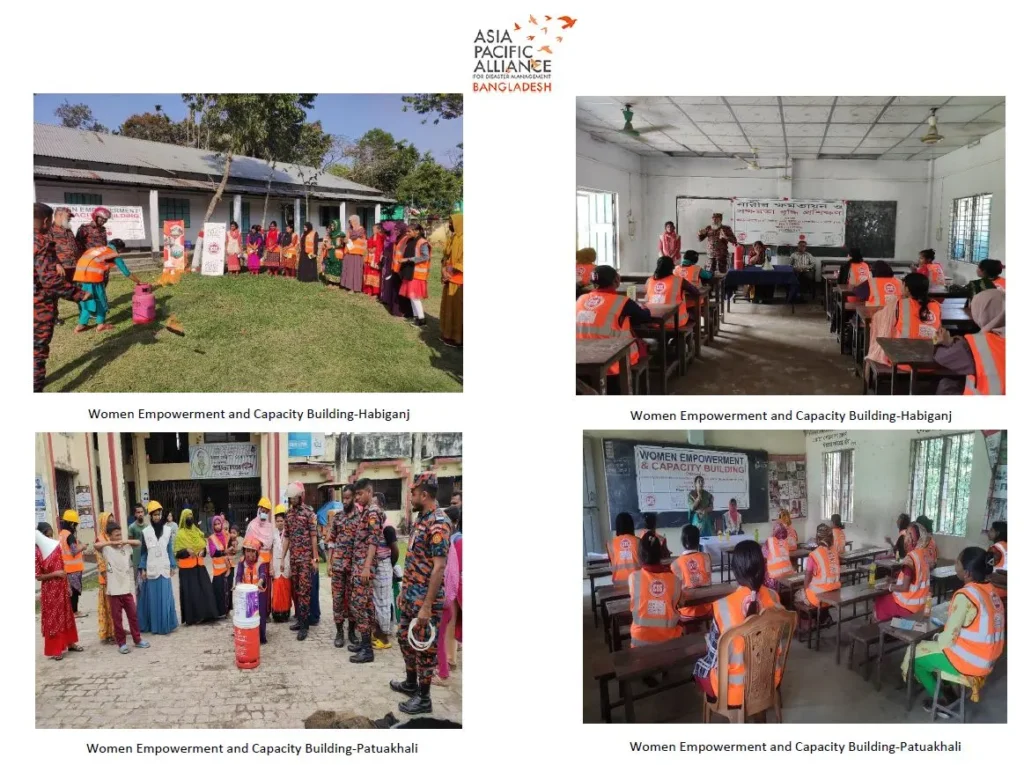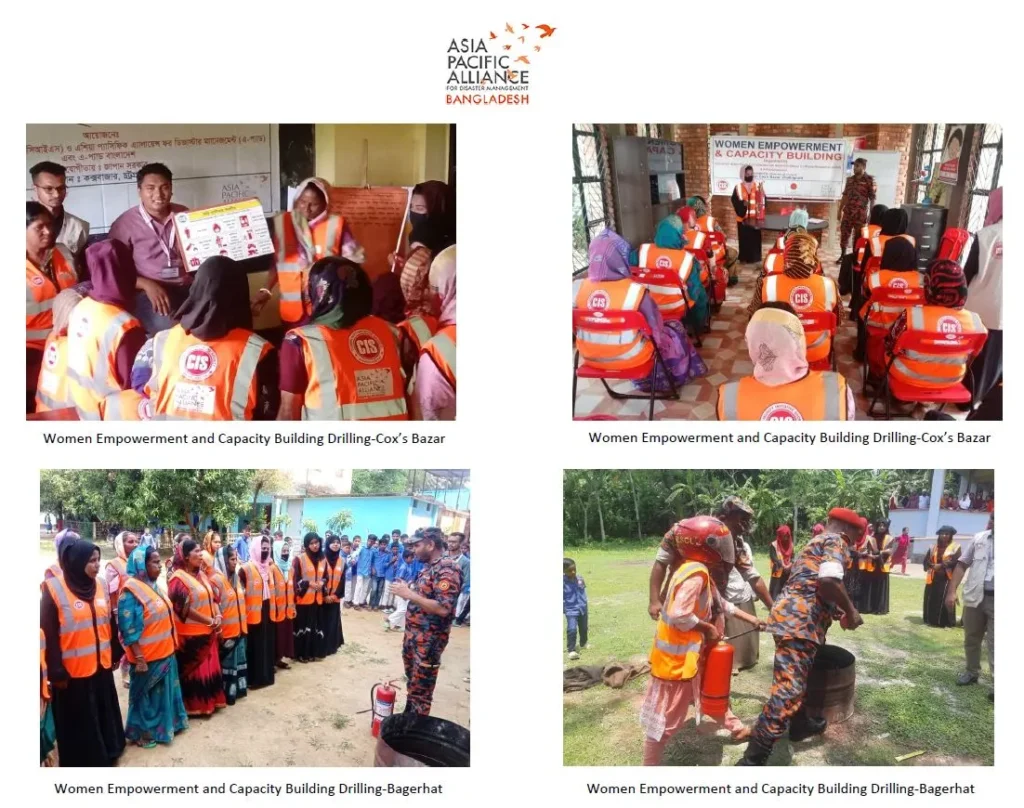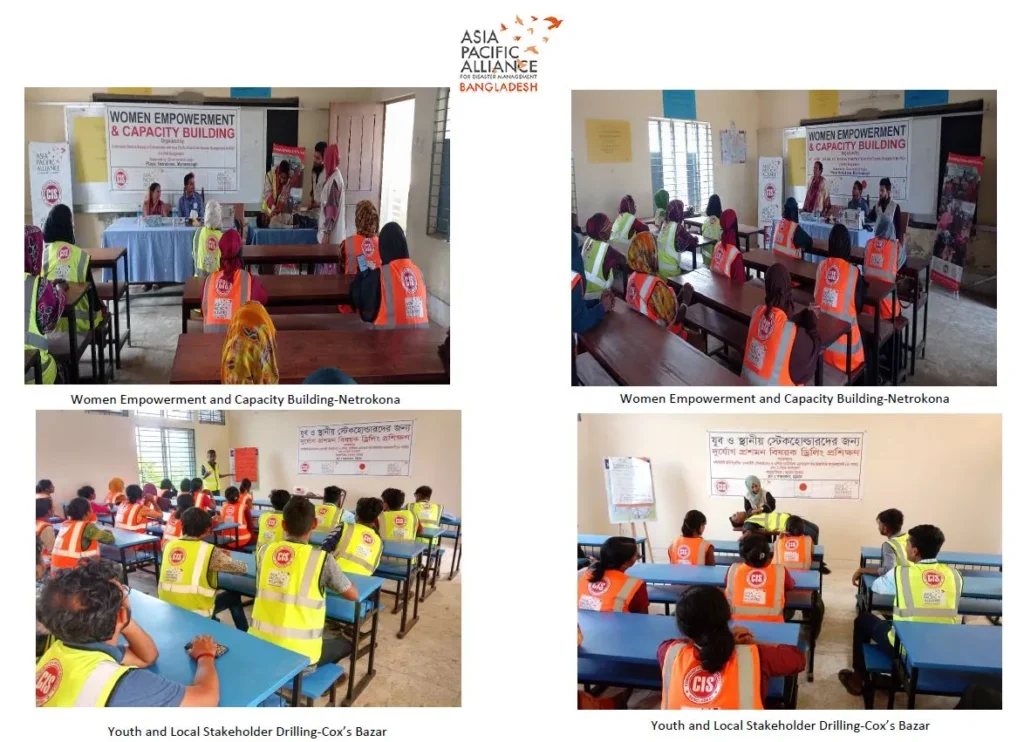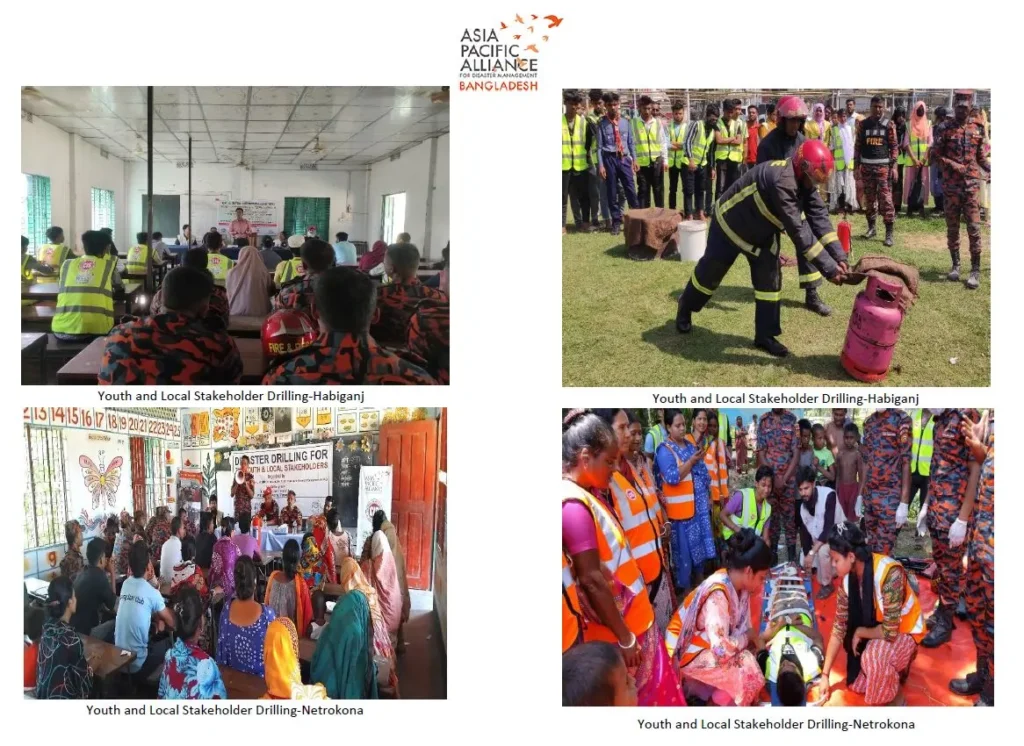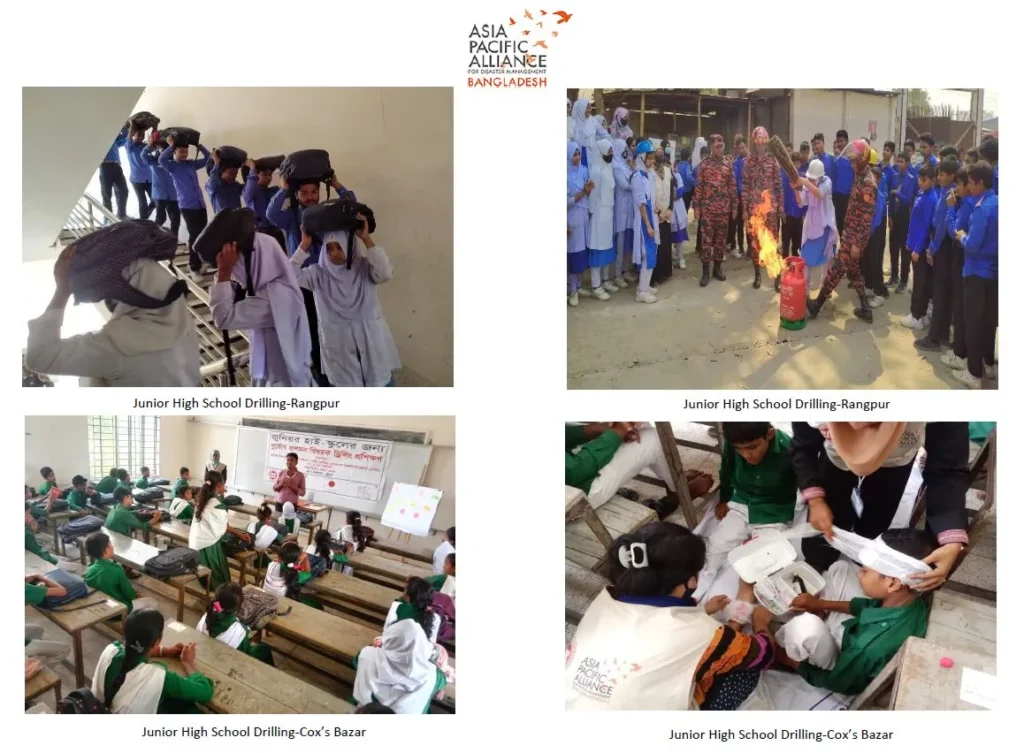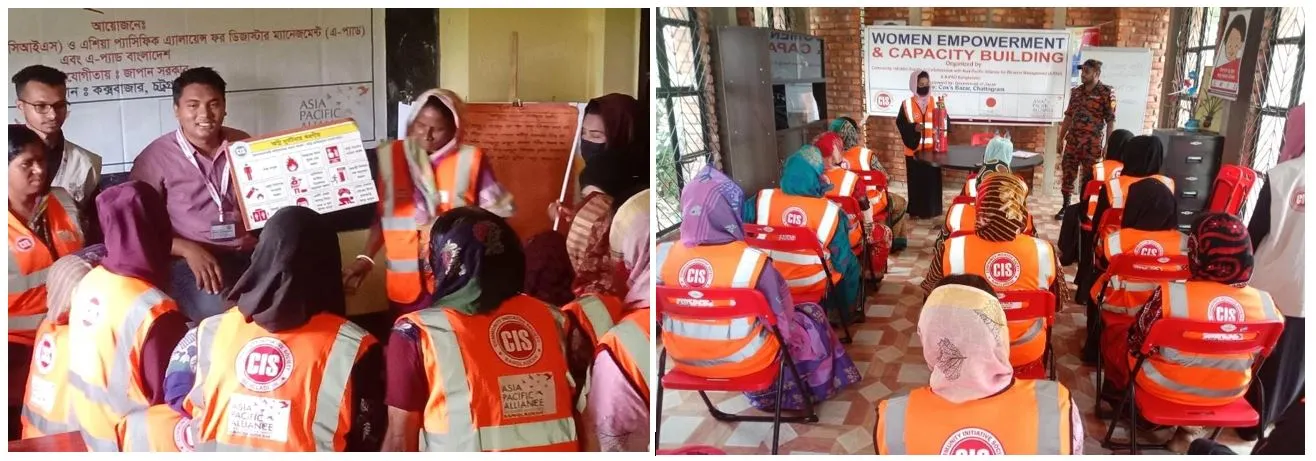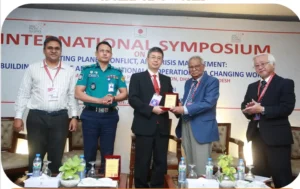Project Title: Strengthening Capacity for Sustainable Disaster Management Network by involving multi-sectoral platform Project Period: 17 January, 2024– 16 January, 2025 (12 month)
- Project Activities and Accomplishments
Bangladesh is ranking as one of the most disaster-prone countries. People in Bangladesh are often affected by water-related natural disasters, including floods, riverbank erosion and cyclones. In addition, recent rapid urbanization increases the risks for earthquake as well as man-made disasters. National Plan for Disaster Management (NPDM) 2021-2025 exemplified the strategic plan of the Government of Bangladesh in its Vision and the Mission of the Ministry of Disaster Management and Relief (MoDMR) between 2021 and 2025 towards building resilient nation. Bangladesh GOVT. has NPDM 2021- 2025 has core goals for actions to save life, reduce economic losses in every disaster cycle stages which includes Disaster Risk Reduction (DRR), Humanitarian Response and Emergency Recovery Management. In Bangladesh most hazards impact: flood; cyclone and surge; tornado; earthquake; riverbank erosion; landslide; salinity intrusion; drought; tsunami; lightning; arsenic contamination; human-induced hazards and health hazards. The last hazard has potential for assuming significance because of the emerging risks in Bangladesh.
A-PAD Bangladesh started project from January 2023 and presently continue it 17 January 2024 to build up capacity on disaster management. It communicates with the different sectors like local community, community leaders, stakeholders, GOVT. officials continuing training on disaster management. To hold training program A-PAD Bangladesh staff organized small community meeting to sharing ideas on disaster and introduced them about A-PAD Bangladesh activity. A-PAD Bangladesh working 8 divisional areas.
2.
There are 1 health workers in each divisions whose are doing home visit and aware the local community about basic disaster awareness. The health workers gave basic ideas about disaster management. A-PAD Bangladesh working at the rural areas. If there would be any directions or announcement from GOVT. or any disaster related news has been published the health workers delivered the message to the local community. Total 17,792 persons were benefited from A-PAD Bangladesh from January to May 2024.
3.
A-PAD Bangladesh attended coordination meeting at the 8 divisions in Office of Deputy Commissioner. At that meeting different NGOs had joined and explained their activities. Besides this what will be the next activities of the GOVT. and NGOs were discussed at that meeting.
1. Strengthening of disaster risk reduction and disaster response system functions through the Emergency Disaster Management Coordination Center | ||
Activities | ( Outcome 1 ) The Emergency Disaster Management Coordination Center operated under this project will function as a disaster response base in each region, leading to the disaster risk reduction in the community and the strengthening of its disaster response system.: | Project Status: Achievements vs Outcome: If the activity is behind the schedule, please write the reason. |
1-1 Operation of Emergency Disaster | 【Indicators of Outcome】 | Total 12,536 people visited to the Disaster Management Coordination |
Management Coordination | 1-1 The Emergency Disaster Management | Center to discuss about disaster preparedness and health related issues. |
Centers Target:Local communities | Coordination Center will be used for coordination meetings among partner organizations and | Dhaka: 1,547 Persons Cox’s Bazar: 1,584 Persons |
10 people×25 days×8 divisions×12 | relevant stakeholders during normal times, and | Pabna: 1,554 Persons |
months =24,000 people | will also serve as a center for health and public | Bagerhat: 1,594 Persons |
health guidance for the local residents. In the time | Patuakhali: 1,542 Persons | |
| of emergency, health services will be provided by | Habiganj: 1,645 Persons |
| emergency health workers. The Emergency | Rangpur: 1,624 Persons |
| Disaster Management Coordination Center will | Netrokona: 1,446 Persons |
| be used by 24,000 local residents (annual | Total = 12,536 Persons |
|
| |
1-2 Disaster Management Awareness Program Target : Local communities, | average) in the target area. (Indicator:number or visitors, record of services provided) | A-PAD Bangladesh conducted Disaster Management Awareness programs at the 8 divisional areas where 2,498 persons have participated. Total 4 times training organized in each month at each |
Community leaders, Local NGOs, |
| divisional areas. |
Private | 1-2 Through the Disaster Management | Dhaka: 313 Participants |
company workers, government | Awareness Program, community residents will | Cox’s Bazar: 318 Participants |
officials | receive the latest disaster information and | Pabna: 311 Participants |
15 people × 8 divisions × 4 times ×12 | knowledge on how to respond to disasters, and | Bagerhat: 310 Participants |
months =5,760 people | people’s awareness of disaster prevention and | Patuakhali: 307 Participants |
| response will be increased. (Indicator:Community disaster preparedness | Habiganj: 310 Participants Rangpur: 316 Participants |
| report) | Netrokona: 313 Participants |
2. Expansion of disaster management network to improve community vulnerability | ||
| (Outcome 2)The network of NPF will be expanded and the capacity of each region for disaster prevention and response will be strengthened. |
|
2-1 Network Partner Meeting | 【Indicator of Outcome】 | A-PAD Bangladesh organized 5 days Network partner Meeting at 5 villages in Rangpur, Netrokona, Pabna and Habiganj. Total 1,044 participants has joined the meeting from 4 areas. 13 February 2024, Keranirhat, Total Participants 50+2=52 Participants 14 February 2024, Burirhat, Total Participants 50 Participants 15 February 2024, Shimulbag, Total Participants 50+3=53 Participants 28 February 2024, Nikhondho, Total Participants 50 Participants 29 February 2024, Lalbag, Total Participants 50+3=53 Participant 03 March 2024-Bikramsri: Total Participant- 50+2=52 Participants 05 March 2024-Lauful: Total Participant- 50+5=55 Participants 06 March 2024-Bori: Total Participant- 50+2= 52 Participants 07 March 2024-Godayun: Total Participant- 50+1= 51 Participants 09 March 2024- Islampur: Total Participant- 50+3=53 Participants 06 April 2024- Nazirpur: Total Participant- 50+2=52 Participants 15 April 2024-Dapunia: Total Participant- 50+1=51 Participants 18 April 2024- Krishnadiar: Total Participant- 50+2= 52 Participants 20 April 2024- Tikori: Total Participant- 50+3= 53 Participants 22 April 2024- Hariyabariya: Total Participant- 50+4=54 Participants 05 May 2024- Rajanagar: Total Participant- 50 Participants 06 May 2024-Digonta: Total Participant- 50+3=53 Participants 07 May 2024- Poil: Total Participant- 50+2= 52 Participants 08 May 2024- Teghoria: Total Participant- 50+4= 54 Participants 09 May 2024- Vadoy: Total Participant- 50+2=52 Participants |
Target : Local communities, | 2-1 | |
Community leaders, Local NGO, | Strategies, mechanisms, and action plans for | |
Private Company Workers, | disaster reduction cooperation are developed | |
Government officials | in each region through discussions at network | |
50 people × 5 villages × 8 divisions = | partner meetings, and a framework for | |
2,000 people | disaster reduction cooperation is established. | |
| (Indicator:Strategic Plan) | |
| 2-2 | |
| MOUs signed with at least 5 new | |
| organizations, including private companies, in | |
| A-PAD Bangladesh NPF to expand the network | |
| (Indicator:number of new MOUs signed) | |
| 2-4 | |
| Resources possessed by A-PAD BGD partner | |
| organizations are provided in emergency | |
| disaster response, and play the role of that | |
| organization in times of emergency. | |
| (Indicator:List of resources such as supplies, | |
| human resources and donations provided by | |
| partner organizations for emergency disaster | |
| response) | The Networking Partners Meeting aimed to foster collaboration among diverse stakeholders, including governmental bodies, NGOs, community organizations, academic institutions, and private enterprises. By bringing together these stakeholders, the meeting provided a platform for dialogue and synergy, enabling the pooling of collective expertise and resources to build a resilient community. Through discussions and workshops, participants were able to identify common challenges and explore innovative solutions to address the multifaceted issues related to disaster management. This collaborative approach promoted a holistic understanding of the challenges faced by Habiganj district and paved the way for coordinated efforts in disaster preparedness and response. The Networking Partners Meeting focused on knowledge exchange and capacity building as essential components of effective disaster management. The five-day agenda included sessions on risk assessment methodologies, emergency response protocols, early warning systems, infrastructural resilience, and community-based interventions. These topics catered to the diverse interests and expertise of the participants, ensuring that critical issues were addressed comprehensively. By sharing best practices, lessons learned, and research findings, the meeting facilitated the transfer of knowledge among stakeholders, enabling them to enhance their capacity in disaster preparedness and response. This knowledge exchange further strengthened the network of collaboration and promoted a culture of continuous learning and improvement. In the network partner meeting A-PAD Bangladesh doing the strategic meeting with the different sectors Govt Officials, private organizations, NGOs, local communities. · Countries at high risk of natural hazards, food security and climate |
|
| change will be identified, facilitating more targeted support to more communities. Risk reduction opportunities will also be further integrated into this support. · Cooperation and coordination modalities with Movement partners and other humanitarian actors will be better defined, to support National Societies in responding to natural disasters and complex emergencies · Technical assistance on disaster preparedness, relief and recovery with a focus on assessment, analysis, strategic planning, programming and learning will be provided as needed. |
2-2 Disaster Preparedness Campaigns Target:Partner organizations and local communities 50 people × 2 times × 8 divisions = 800 people |
| |
2-3 Network Partners Capacity Strengthening (DRR) Target:Partner organizations 20 people × 2 organizations × 2 times × 8 divisions = 640 people | A-PAD Bangladesh Organized Network Partner Capacity Strengthening DRR at 7 divisional areas in Patuakhali, Dhaka, Cox’s Bazar, Mymensingh, Habiganj, Rangpur and Bagerhat. Total 297 Participants joined at the training workshop. 10-11 February 2024, Patuakhali, total Participants 40+3 =43 Participants 06 -07 March 2024, Dhaka, Total Participants 40+2= 42 Participants 10 -11 March 2024, Cox’s Bazar, Total Participants 40+1= 41 Participants 03-04 April 2024, Mymensingh, Total Participants 40+1= 41 Participants 06-07 April 2024, Habiganj, Total Participants 40+3= 43 Participants 08 -09 May 2024, Rangpur, Total Participants 40+3= 43 Participants 11 -12 May 2024, Bagerhat, Total Participants 40+4= 44 Participants NGOs have been working along with the government in rebuilding the country and realizing the nation’s aspirations. Eventually, arising from |
|
| the institutional dynamics of a participatory approach to grassroots development, NGOs stepped into many other development sectors such as community capacity -building through health, education, water supply and sanitation, shelter and infrastructure, livelihood supports, nutrition, and environmental management. NGOs are also providing relief and rehabilitation supports to natural hazards -affected communities. Although the state is the leading actor integrating DRR (Disaster Risk Reduction) into policy strategies, the reformation of top – down governance in neoliberal societies and the government’s incapacity amplifies the scope of NGOs’ involvement in development. Disaster risk reduction (DRR) is a forward -looking strategy that seeks to reduce the impact of disasters by analyzing future disaster risk, making calculated predictions, assessing current vulnerabilities and building resilience. |
2-4 Seminar for Developing New Disaster Prevention Solutions Target : NGO, Disaster prevention related government organizations, Private sector personnels 30 people (2days)× 8 divisions × 2 times = 480 people |
Two days seminar has been organized in Dhaka, Cox’s Bazar, Pabna, Bagerhat, Habiganj and Patuakhali. Total 267 participants from 6 divisional areas had joined the seminar. 13 -14 February 2024, Pabna, Total participants 30+2=32 Participants 17 -18 February 2024, Cox’s Bazar, Total participants 30+3=33 Participants 24 -25 March 2024, Bagerhat, Total participants 30+3=33 Participants 27 – 28 March 2024, Dhaka, Total participants 30+2=32 Participants 27 -28 March 2024, Habiganj, Total Participants 30+5=35 Participants 17 -18 April 2024, Bagerhat, Total participants 30+5=35 Participants 05 -06 May 2024, Dhaka, Total participants 30+2=3 2 Participants 15 -16 May 2024, Patuakhali, Total Participants 30+5=35 Participants Disasters also have pervasive impacts on the society and have the potential not only to destabilise the economy, but also the access to education, livelihood opportunities, food security, housing and service |
|
| provision (including healthcare). In Bangladesh, the impacts of flooding, cyclones, storm surges, landslides and droughts to a geographically unique and highly vulnerable ecological and human systems have led to a large-scale destruction of housing, land and property, and loss of livelihoods alongside increasing displacement and disaster-driven migration. Disasters also affect accessibility. Despite the urbanization trend and increasing infrastructure in Bangladesh, landslides, storms, flooding and earthquakes have the potential to significantly disrupt road networks, which then affects the ability to access shelters, healthcare, education and – on a wider scale – have implications on reducing poverty as poor access to markets are the cornerstones of livelihood generation · Ensuring that disaster risk reduction is a national and local priority with strong institutional basis for implementation; · Identifying, assessing and monitoring disaster risks and enhancing early warning; · Using knowledge, innovation and education to build a culture of safety and resilience at all levels; · Reducing the underlying risk factors; · Strengthening disaster preparedness for effective response at all levels |
2-5 International Symposium on DRR Target : Government, Local government, private company, NOG, partner organization, representative of A-PAD member countries, etc. 200 people |
|
3. Practical training to improve resilience of local communities | ||
| ( Outcome 3 ) Contribute to improving the disaster resilience of local communities through practical training. |
|
3-1 Disaster response capacity building of local community level in Health and hygiene field | 【Indicator of Outcome】 3-1 a) Establish networks of community leaders who can lead disaster response and emergency health response in all districts of Bangladesh. (Indicator:Number and the List of community leaders for disaster response/emergency health in each 8 districts.) b) Networks of human resources with the skills and know-how to respond to health emergencies will be established in all districts of Bangladesh to provide health services to the local residents in times of emergency. (Indicator:Data of NGO health personals who can respond in emergency. Number of residents who received the services in the cases of activities during emergency disaster in each 8 districts.) 3-2 a) Disaster preparedness training and drills will be documented in a manual, and |
|
3-1 a) Workshop on Disaster Management and Emergency Health Response Target:Local residents, Community leaders, Local NGO workers 25 people (2 days)× 8 divisions × 2 times = 400 people | A-PAD Bangladesh conducted 2 days workshop at Bagerhat, Rangpur, Cox’s Bazar, Netrokona and Pabna total 136 participants joined the training workshop. 10-11 February 2024, Bagerhat, Total 25 participants 16-17 April 2024, Rangpur, Total 25+3=28 participants 27-28 April 2024, Cox’s Bazar, Total 25+2=27 Participants 04-05 May 2024, Netrokona, Total 25+2=27 participants 14-15 May 2024, Pabna, Total 25+4=29 participants
Concerning capacity building and public awareness raising it was acknowledged that efforts have been undertaken in the past and that the need for each country differs. Nevertheless, there is a need for training in several areas and the need for advancement of public education and awareness taking stock of good lessons already existing in the region. The DRR priorities are representing the immediate needsin the region to enhance the implementation of the CDM strategy and the Sendai Framework in the contextual priorities. In this sense, countries and organizations working in Bangladesh can be guided by these areas identifying the focus of support. The priority areas and actions are an input to overall regional priorities. | |
| women, youth groups, and local stakeholders who participate in the drills will be granted certificates of completion and work as disaster volunteer teams during actual disasters. (Indicator:Drilling Manual, Cases of activities in emergency disaster response) b) Disaster drills at junior high schools will be documented in a manual so that students who participate in the drills will have the skills to take appropriate action in the event of a disaster. (Indicator:Drilling Manual, Report of emergency disaster response) | a. Early Warning Systems (EWS) b. Community Resilience c. Capacity Building, Training and Public Awareness d. Institutional Strengthening e. Private-Public Partnership The workshop prioritized aiding, supporting, and treating victims to save lives during disaster and emergency response efforts. The initial day of the training focused on the primary disaster prevalent in Dhaka, which is mainly heat-related due to the city’s nature as a metropolitan area with extensive urbanization. Discussions during the workshop centered on methods to increase greenery at the household level to combat this issue. Bangladesh’s geographical location and geology make the country highly vulnerable to a wide range of natural hazards, compounded by the effects of climate change and variability. Anthropogenic influences, such as urbanization, deforestation, and inadequate physical development planning, exacerbate this vulnerability, leading to elevated risks and impacts |
3-1 b) Training of Local Health Workers on Disaster Health Activities Target:Health workers who belong to local NGOs or civil organizations 20 people(3 days)× 8 divisions = 160 people | A-PAD Bangladesh organized local health workers training at Pabna and Cox’s Bazar. Total 47 participants joined the training. 23-25 April 2024, Pabna, Total 20+2=22 Participants 19-21 May 2024, Cox’s Bazar, Total 20+5=25 Participants
The training program conducted by CIS for local health workers in Cox’s Bazar and Pabna was a comprehensive and detailed initiative aimed at enriching the knowledge and skills of local health workers in managing health-related issues during disasters. The program was thoughtfully designed to encompass a wide array of topics including disaster risk reduction, emergency response, and public health interventions during disasters, segmented into various modules, each addressing specific |
|
| aspects of disaster health activities. Throughout the training, participants received instruction on methods for conducting rapid health assessments, identifying and managing common health issues during disasters, and providing psychosocial support. The theoretical sessions were focused on establishing a solid knowledge base, while the practical sessions provided hands -on experience in applying learned skills and knowledge in simulated disaster scenarios. |
3-2 Strengthening disaster response capacities of local communities through disaster drilling training |
| |
3-2 a) Women Empowerment and Capacity Building Target: Women’s groups in target villages 20 people (2 days)× 8 divisions × 2 times = 320 people | A-PAD Bangladesh conducted 2 days workshop at Patuakhali, Habiganj, Netrokona, Cox’s Bazar and Bagerhat. Total 161 participants joined the drilling session. 12 -13 February 2024, Dhaka, Total Participants 20+4=24 Participants 13 -14 February 2024, Patuakhali, Total Participants 20+3=23 Participants 20-21 March 2024, Habiganj, Total Participants 20+2=22 Participants 27-28 March 2024, Netrokona, Total Participants 20+5=25 Participants 23 -24 April 2024, Galachipa, Total 20+2=22 Participants 11 -12 May 2024, Cox’s Bazar, Total 20+3=23 Participants 20 -21 May 2024, Bagerhat, Total 20+2=22 Participants The program offers training and capacity building activities for women, focusing on topics such as disaster awareness, emergency response, and risk reduction. The training encompasses disaster preparation, safety protocols during disasters, and accessing assistance in their aftermath. By involving women in disaster planning, we aim to enhance their empowerment and contribute to building resilience in |
|
| communities. Women provide unique perspectives in identifying disaster risks and fostering security for their families, thereby reducing stereotypes and discrimination. In alignment with Community Initiative Society’s broader objectives, this program underscores our commitment to promoting women’s empowerment, capacity building, and creating a more equitable and sustainable society. Recently, CIS organized a two -day event specifically geared towards women’s empowerment and capacity building. The event was designed to equip women with the skills and knowledge necessary for assuming leadership roles and engaging in decision -making processes. Through a series of practical activities, participants were able to engage in experiential learning and skill development. |
3-2 b) Disaster Drilling for the Youth and Local Stakeholders Target: Youth in the local private and civic sector 45 people(2 days)× 8 divisions × 2 times = 720 people | Youth and local stakeholder drilling program organized in Pabna, Habiganj,Cox’s Bazar,Bagerhat, Netrokona and Dhaka where 289 participants joined. 27 -28 February 2024, Pabna, Total Participants 45+5=50 participants 05 -06 March 2024, Habiganj, Total Participants 45+2=47 Participants 19 -20 march 2024, Cox’s Bazar, Total Participants 45+3=48 Participants 29 -30 April 2024, Bagerhat, Total 45+3=48 Participants 15 -16 May 2024, Netrokona, Total 45+ 2=4 7 Participants 15 -16 May 2024, Dhaka , Total 45+ 4=4 9 Participants
The CIS team was well -prepared and focused on building up the capacity of the participants for emergency response. The program covered a wide range of topics such as the impact of climate change on multiple disasters, ways to protect against lightning, first aid treatment, and basic hygiene and sanitization. The participants were also trained on how to recognize the signs of an impending disaster and how to take appropriate measures to minimize the damage. During the training |
|
| program, a highly experienced fire fighter, shared his insights on fire safety and disaster risk management. He explained the different ways fires could start, such as through short circuits, gas cylinders, or paper, and emphasized the need to adopt different methods to deal with each type of fire. For example, if a gas cylinder is leaking, it’s best to open the door and window of the room and wrap it with wet sacks or blankets if it catches fire. If a fire starts due to a short circuit, the main switch should be closed if possible. In addition to fire safety, the program also covered other types of disasters that are common in the area, such as cyclones, tidal floods, erratic rainfall, cold waves, arsenic contamination, and tornadoes. The participants were trained on how to prepare for these disasters and how to respond quickly and efficiently during and after the disaster · Assess the response mechanism of the first responders · Enhance coordination among the emergency support functioning agencies · Awareness creation among the participants |
3-2 c) Disaster Drilling for Junior High Schools Target:School Children 40 people (2 days)× 8 divisions × 2 times = 640 people | Disaster Drilling for Junior High School conducted in Cox’s Bazar, Netrokona, Habiganj, Rangpur, Pabna,Bagerhat, Patuakhali and Dhaka. Total 517 participants joined the drilling program. 13 -14 February 2024, Cox ’s Bazar, Total Participants 40+4=44 Participants 17 -18 February 2024, Netrokona, Total Participants 40+3=43 Participants 24 -25 February 2024, Habiganj, Total Participants 40+2= 42 Participants 11-12 March 2024, Rangpur, Total Participants 40+ 2=4 2 Participants 12-13 March 2024, Pabna, Total Participants 40+ 3=4 3 Participants 13-14 March 2024, Bagerhat, Total Participants 40+ 4=4 4 Participants 18-19 March 2024, Galachipa, Total Participants 40+ 3=4 3 Participants 28 -39 April 2024, Habiganj, Total 40+5=45 Participants |
|
| 29 -30 April 2024, Cox’s Bazar, Total 40+2=42 Participants 13 -14 May 2024, Patuakhali, Total 40 Participants 29 -30 May 2024, Dhaka, Total 40+3=43 Participants 29 -30 May 2024, Rangpur, Total 40+6=4 6 Participants Bangladesh is a more disaster -prone area. For geographic location and weather conditions, cyclones, tidal floods, erratic rainfall, cold waves, arsenic contamination, and tornadoes are common in this area. Community Initiative Society (CIS) in Collaboration with Asia Pacific Alliance (A – PAD) implementing a Strengthening Capacity for Sustainable Disaster Management Network by involving multi – sectoral Platform. In her speeches, she said, CIS role along with the CPP role is very important in natural disaster management. She said that this type of demonstration by volunteers can save lives and livelihoods if a disaster happens. It was also expressed hope that this kind of exercise would help the local people what to do before the disaster.Participants gave thanks to CIS team and expressed gratitude for organizing such kind of training. It is also added that local people as well as students will be able to protect their lives and property during a disaster by the learning of the event. It is noted that CIS in collaboration with FSCD facilitated the mock drill programme. They have demonstrated what to do during cyclones, landslide floods, floods; floods caused by heavy rains, making stoves during floods, how to keep safe drinking water, what to do in case of fire, etc. They have demonstrated what to do during cyclones, landslides, floods, floods caused by heavy rains, rules for keeping dry food, teaching children to swim, making stoves during floods, how to keep safe drinking water, what to do in case of fire, etc. Students participated in the training session actively as they enjoyed the session. They shared that this training helps them to learn more about disasters and now they know how to save themselves in case of fire or any emergency incident. In the training session there was one |
|
|
4. Challenges
Due to the recent heat wave, organizing outdoor drilling sessions has been challenging. To mitigate the effects of the heat, our organization, CIS, took additional measures such as providing water and ORs, and attempted to conduct the drilling sessions in shaded areas or under trees
5. Practice in collaboration with A-PAD Bangladesh Network Partners
Last year, A-PAD Bangladesh entered into a memorandum of understanding with the media, resulting in wider dissemination of A-PAD Bangladesh activities through publication in local newspapers.
6. Any contribution Funds Received and Grants Applied / Planned and Implemented Projects by CIS including Emergency Response
During Cyclone Remal, A-PAD Bangladesh successfully collected funds from its networking partners, including Eastern Housing Ltd, Seven One Limited, DHEM Foundation, and Maysha Transport. The contributions from these partners enabled A-PAD Bangladesh to respond promptly to the cyclone.
7. Relationship with Bangladesh Government and Japanese Embassy
A-PAD Bangladesh actively participated in the Inauguration program for the procurement of radiology equipment under the GGHSP project of the Embassy of Japan in Bangladesh. The ceremony was graced by the presence of H.E Mr. HOSAKA Yasushi, Honorable Parliamentary Vice-Minister for Foreign Affairs of Japan, and H.E Mr. IWAMA Kiminori, Ambassador of Japan to Bangladesh, who visited and inaugurated a modern digital x-ray & OPG machine in the radiology department of Dhaka Community Hospital. During the event, A-PAD Bangladesh presented updates on its activities.
